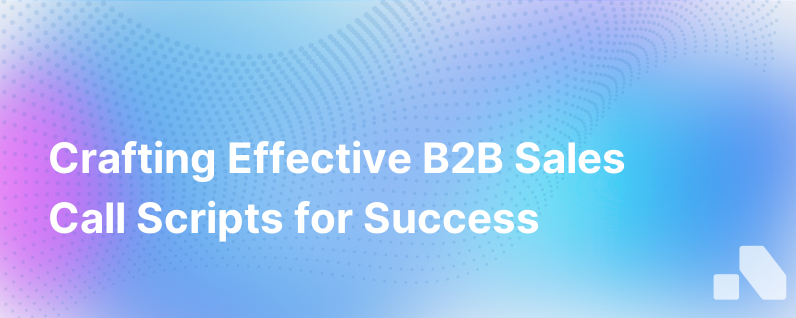
When it comes to B2B sales, the adage "You only have one chance to make a first impression" rings particularly true. That's because in the world of complex sales cycles and discerning customers, every touchpoint matters — particularly sales calls. A call can make or break a deal. To increase the odds of a successful outcome, it’s essential to strategize beforehand and part of this involves crafting an effective sales call script.
A well-written B2B sales call script does more than provide a rigid verbatim monologue. It serves as a framework to navigate conversations, ensuring that you touch on key points, anticipate and address potential objections, and most importantly, listen and adapt to the prospect’s responses.
Understanding the Purpose of B2B Call Scripts
Before diving into how to write a B2B sales call script, let's clarify what a script should achieve.
- Structure: It should guide the conversation logically, from the initial greeting to the closing.
- Consistency: It helps ensure that all prospects receive the same level of information and experience.
- Training Tool: It assists in training new sales reps and standardizing the sales process.
- Improv Monitor: It acts as a baseline for personal improvisation and adaptation during the call.
Crafting Your B2B Sales Call Script
1. Pre-Call Research
The foundation of a killer B2B sales call script lies in pre-call research. Have a clear understanding of the prospect’s business, industry challenges, and potential opportunities for your offering to solve their pain points. Familiarize yourself with recent developments in their company, like new product launches or leadership changes. Tools like LinkedIn, company news, and industry reports are invaluable for gathering this intel.
2. Introduction
Your introduction should be succinct, friendly, and professional. Start by confirming you're speaking with the right person and explain the reason for your call. Gain permission to proceed, showing respect for their time.
“Hello [Prospect’s Name], this is [Your Name] from [Your Company]. Is this a good time to chat? I wanted to discuss [specific reason for the call] and share some insights that could be valuable for your team at [Prospect’s Company].”3. Elevator Pitch
Craft a brief pitch that encapsulates who you are, what your company does, and the unique value you offer. This should be no more than a couple of sentences designed to pique interest and lead toward a more in-depth conversation.
4. Qualification Questions
Prepare a list of open-ended questions that will help you understand the prospect's needs, qualify their potential, and engage them in the discussion. This section should be flexible to allow for natural dialogue.
For instance:
“What challenges are you currently facing in [relevant business area]?”
“How are you currently addressing [a problem your product solves]?”5. Handling Objections
Anticipate common objections and arm yourself with concise, convincing responses without being confrontational. An objection is an opportunity for further dialogue.
6. Benefits Over Features
Focus on how your product or service benefits the client’s business rather than listing features. Paint a picture of the tangible outcomes they can expect.
7. Case Studies
Have a couple of brief case studies or testimonials at hand that encapsulate how your product has helped similar businesses overcome challenges or achieve goals. Real-world applications are potent sales tools.
8. Trial Closes
Throughout the conversation, utilize 'trial closes’ to gauge prospect engagement and agreeance. For example:
“Does this sound like it could be a helpful solution for your current needs?”9. Ask for the Next Step
Never end a call without a clear call to action. Whether it's scheduling a follow-up call, a demo, or sending further information, ensure both parties understand and agree on the next step.
10. Closing
Thank the prospect for their time, summarise the agreed-upon next steps, and provide them with your contact information.
“Thank you for your time today, [Prospect’s Name]. To recap, we’ve agreed I will [next steps]. Let's tentatively schedule this for [time frame]. In the meantime, feel free to reach me at [contact details] for any further questions.”Best Practices for Using B2B Sales Call Scripts
- Personalize: Always tweak the script to the prospect's unique situation and use their language. Add annotations to your script based on your pre-call research for a more personalized touch.
- Practice: Familiarize yourself with the script but don’t memorize. Practice should be about smooth delivery, not rote repetition.
- Listen: A script should guide conversation, not dominate it. Actively listen and be ready to deviate from the script based on the prospect's responses.
- Adjust: Note what works and what doesn't, and refine your script accordingly. Feedback from prospects and results over time will tell you which approach resonates.
- Cadence and Tone: Keep your voice upbeat but authoritative. You want to come across as confident but not overbearing.
Finally, remember that a sales call script is only as effective as the flexibility and judgment you apply while using it. Sales is about building relationships, so while you’ll want to stick to your key points, it’s just as important to build rapport and learn about your prospect as the conversation unfolds.
Effective scripts are not the end goal but rather the framework for more substantial sales conversations — support guides as you seek to connect with B2B buyers on a personal level, leading to better client relationships and, ultimately, successful sales outcomes. Any tool that can automate or simplify the intricate process of understanding customer needs, like Aomni’s AI platform for B2B sales, can be a powerful addition to your sales toolkit.